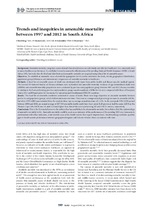| dc.contributor.author | Neethling, Ian | |
| dc.contributor.author | Groenewald, Pam | |
| dc.contributor.author | Schneider, Helen | |
| dc.contributor.author | Bradshaw, Debbie | |
| dc.date.accessioned | 2020-03-09T11:13:08Z | |
| dc.date.available | 2020-03-09T11:13:08Z | |
| dc.date.issued | 2019 | |
| dc.identifier.citation | Neethling, I., Groenewald, P., Schneider, H., & Bradshaw, D. (2019). Trends and inequities in amenable mortality between 1997 and 2012 in south africa. South African Medical Journal, 109(8), 597-604. doi:10.7196/SAMJ.2019.v109i8.13796 | en_US |
| dc.identifier.issn | DOI: 10.7196/SAMJ.2019.v109i8.13796 | |
| dc.identifier.uri | http://hdl.handle.net/10566/5202 | |
| dc.description.abstract | Background. Amenable mortality comprises causes of death that should not occur with timely and effective healthcare. It is commonly used to assess healthcare performance. It could also be used to assess the effectiveness of the pending National Health Insurance (NHI) in South Africa (SA), but to do this, the level and distribution of amenable mortality are required using a local list of amenable causes. Objectives. To establish an amenable cause-of-death list appropriate for SA and to determine the levels, trends, geographical distribution, population group differences and international comparisons of mortality amenable to healthcare. Methods. A local list of amenable causes of death was developed with input from public health and disease-specific medical experts. The Second SA National Burden of Disease estimates were reclassified into amenable mortality. Analyses of age-standardised death rates (ASDRs) and amenable mortality proportions were conducted by province and population group between 1997 and 2012. Excess mortality in relation to the best-performing province and population group was also analysed. ASDRs for SA were compared with those of European Union (EU) and Organisation for Economic Co-operation and Development (OECD) countries. Results. The local list of amenable conditions contained 45 causes of death. There were large disparities in amenable mortality between provinces and population groups, which did not attenuate over time. There was an average annual percentage increase in amenable ASDRs, but when HIV/AIDS was excluded from the analysis there was an average annual decrease of 1.12%. In the post-peak HIV/AIDS period between 2008 and 2012, an annual average of 207 810 amenable deaths could have been saved if all provinces had the same ASDR as the Western Cape. SA’s ASDR was 2.6 and 2.2 times higher than that of the worst-performing EU and OECD country, respectively. Conclusions. This is the first study known to the authors that has established a local amenable mortality list and described the epidemiology of amenable mortality in SA. Amenable mortality could be used as an indicator of the performance of the pending NHI over time and, in combination with other indicators, could identify areas of the health system that require improvement. Benchmarking could also quantify gaps in health system performance between geographical regions and indicate whether these are reduced with time. | en_US |
| dc.language.iso | en | en_US |
| dc.publisher | South African Medical Journal | en_US |
| dc.subject | AIDS patient | en_US |
| dc.subject | Female | en_US |
| dc.subject | Maternal death | en_US |
| dc.subject | Epidemiology | en_US |
| dc.subject | Mortality | en_US |
| dc.title | Trends and inequities in amenable mortality between 1997 and 2012 in South Africa | en_US |
| dc.type | Article | en_US |

